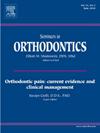Growth of the maxillary apical base in post-adolescents with craniofacial dysmorphism using ATOZ™ orthodontic distraction osteogenesis
IF 2.2
4区 医学
Q2 DENTISTRY, ORAL SURGERY & MEDICINE
引用次数: 0
Abstract
Recent innovations in orthodontic devices utilizing orthodontic mini-implants and mini-screws have allowed orthodontists to enhance the management of craniofacial skeletal disparities nonsurgically. The ATOZ™ orthodontic distractor was invented in 2017 in Korea with the primary directive of growing the maxillary apical base without involving teeth or general anesthesia-required surgery in its application. Its 8.2 mm transverse footprint is ideal for patients who display craniofacial dysmorphism with a severely constricted maxillary apical base. ATOZ™ can withstand up to 50 kg-force of compression without permanent deformation and reverts to its original shape effortlessly. This unique property allows ATOZ™ to apply heavy orthopedic force to the median palatine suture and circummaxillary sutures in a continuous manner over a long period of time. Three exemplary clinical cases treated with ATOZ™ are presented in this article with an emphasis on its slow activation protocol, different from the conventional rapid activation protocol for Rapid Palatal Expander (RPE) or Mini-implant Assisted RPE. With its innovative design and unique biomechanical property of springiness coupled with the slow activation protocol inducing physiological sutural distraction osteogenesis, ATOZ™ may present a ground-breaking opportunity in enlarging the maxillary apical base without adverse effects for post-adolescents with craniofacial dysmorphism and reduce the need for complex craniofacial surgeries.
利用 ATOZTM 正畸牵引成骨技术促进颅面畸形青少年上颌尖底的生长
最近在使用正畸微型植入物和微型螺钉的正畸装置方面的创新使正畸医生能够通过非手术方式加强对颅面骨骼差异的管理。ATOZ™正畸牵张器于2017年在韩国发明,其主要目的是在不涉及牙齿或全麻手术的情况下种植上颌根尖基。其8.2毫米的横向足迹是理想的患者谁显示颅面畸形与严重狭窄的上颌根尖基础。ATOZ™可以承受高达50公斤的压缩力而不会永久变形,并且可以毫不费力地恢复到原始形状。这种独特的特性使ATOZ™能够在很长一段时间内连续地对腭中缝和上颌周围缝合线施加沉重的矫形力。本文介绍了ATOZ™治疗的三个典型临床病例,重点介绍了其慢激活方案,不同于快速腭扩张器(RPE)或Mini-implant Assisted RPE的传统快速激活方案。凭借其创新的设计和独特的弹性生物力学特性,再加上诱导生理性缝合线牵张成骨的缓慢激活方案,ATOZ™可能为扩大上颌尖基提供开创性的机会,而不会对颅面畸形的青春期后患者产生不良影响,并减少复杂颅面手术的需要。
本文章由计算机程序翻译,如有差异,请以英文原文为准。
求助全文
约1分钟内获得全文
求助全文
来源期刊

Seminars in Orthodontics
DENTISTRY, ORAL SURGERY & MEDICINE-
CiteScore
2.20
自引率
4.80%
发文量
28
审稿时长
10 days
期刊介绍:
Each issue provides up-to-date, state-of-the-art information on a single topic in orthodontics. Readers are kept abreast of the latest innovations, research findings, clinical applications and clinical methods. Collection of the issues will provide invaluable reference material for present and future review.
 求助内容:
求助内容: 应助结果提醒方式:
应助结果提醒方式:


